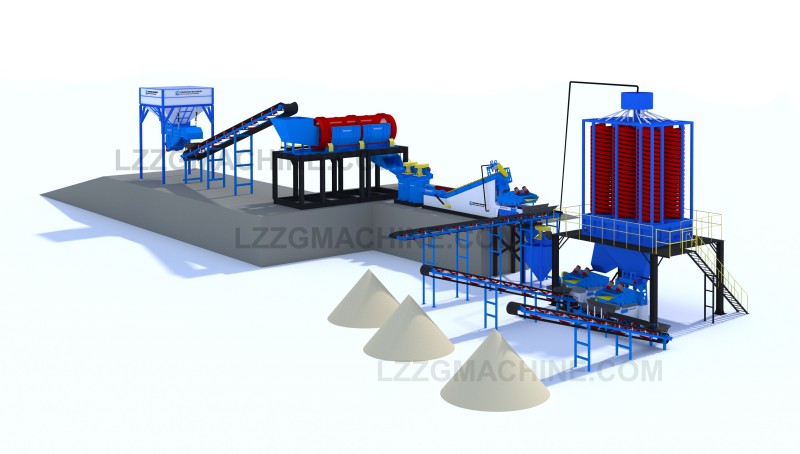Removing iron from silica in sand washing processing
 October.06,2019
October.06,2019
Silica sand is an important non-metallic mineral raw material with a wide range of uses. The content of quartz sand iron directly affects the quality of the product. This paper mainly introduces the advantages and disadvantages of mechanical scrubbing and iron removal, magnetic separation, ultrasonic iron removal, flotation iron removal and acid pickling. With the development of microelectronics, optoelectronics and other industries, the excellent performance of high-purity quartz sand makes other powders irreplaceable, and the market prospect is extremely broad.

silica sand production plant
Quartz sand, also known as silica sand, glass sand is an important non-metallic mineral raw material widely used in glass, casting, ceramics and refractory materials, metallurgy, construction, chemicals, plastics, rubber, abrasives and other industries. Fengyang quartz sand is mainly used to manufacture glass, and the content of iron in quartz sand directly affects the quality of the product. The purity requirement of quartz sand in high-tech field is harsh: generally requires SIO2 content greater than 99.99%, impurity content, especially The content of iron impurities is limited to a very low range, so it is very important to increase the taste of quartz sand in the production process to reduce the content of iron.
In silica sand, the main mineral is quartz, and it also contains some other impurity minerals. The impurity minerals containing iron are hematite, magnetite, goethite and so on. These iron-containing impurities are either embedded in the quartz particles or attached to the quartz surface. Because the presence of these iron-containing impurities greatly reduces the use-value of quartz sand, affecting the quality of the product, such as in the production of glass, iron-containing impurities will cause greater harm to the production and quality of the glass, especially for glass melting. The thermodynamic properties of the process and the light transmission of the finished glass. Currently used in iron removal technology mainly have the following methods:
1.Mechanical scrubbing

Mechanical scrubbing is the removal of iron from the surface of quartz sand and iron-containing minerals adhering to the surface of quartz sand by means of mechanical external force and collision and friction between sand particles. Currently, scrubbing techniques are primarily rod scrubbing and mechanical scrubbing. Compared with other iron removal processes, the process has the following characteristics: First, the product quality is good, and the quality requirements of float glass for high-quality silica sand can be achieved; second, the output is large. Now some small-scale production and processing companies use this method to remove more iron because it is cheaper and easier to operate, but the iron removal rate is relatively low.
2. Magnetic separation to remove iron from silica sand

Magnetic separation is divided into a dry selection and wet selection. The comparison between dry selection and wet selection shows that the wet magnetic separation has the defects of large magnetic consumption, easy wear of the medium, large production water consumption, high operation, maintenance cost. The dry strong magnetic separation process is easy to operate, and the operation and maintenance costs are lower than the wet type. In the magnetic separation process, the wet magnetic separator can remove the weak magnetic impurity minerals such as hematite, limonite, and biotite including the continuum particles.
3. Ultrasonic iron removal
Ultrasonic iron removal is primarily a secondary iron film (ie, “thin-film iron”) that removes the surface of the particles. The iron film is firmly bonded and the mechanical scrubbing method used in the beneficiation cannot be separated.
4. Flotation and iron removal
The flotation method can be divided into three types: the first one is a fluorine acid method. This method is widely used because of its good flotation effect, easy control, and stable index.
5. Acid leaching iron
Acid leaching and iron removal The use of quartz is insoluble in acid (except HF), and the impurity mineral containing Fe can be dissolved by acid so that the purpose of removing iron-containing minerals from quartz sand can be achieved.





